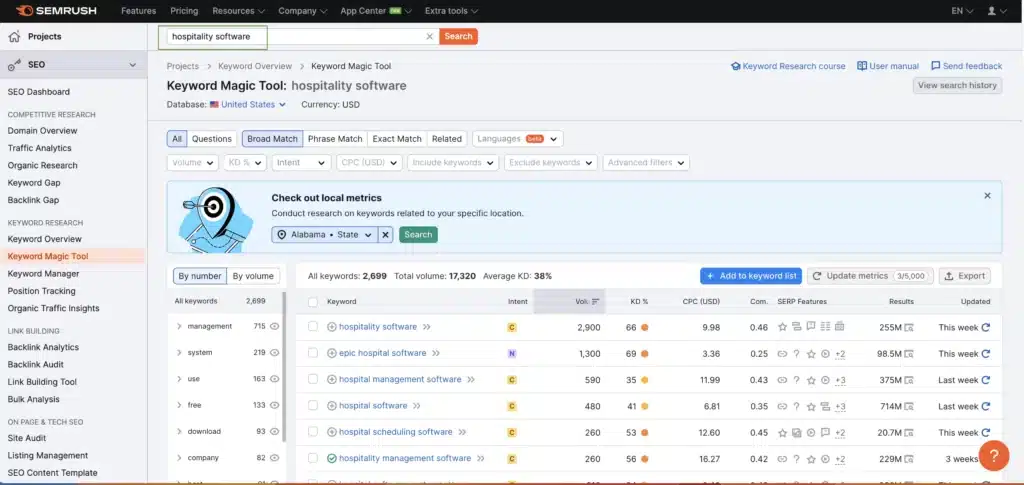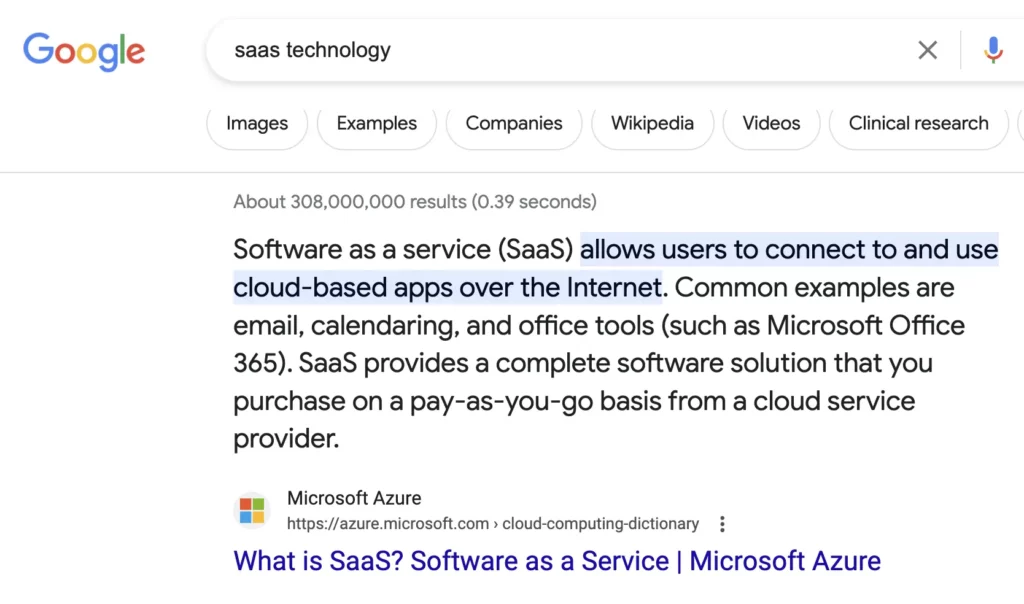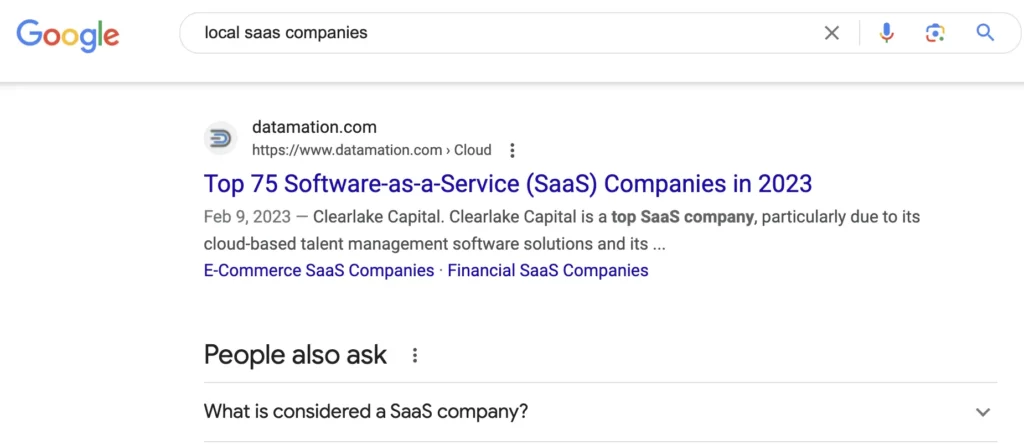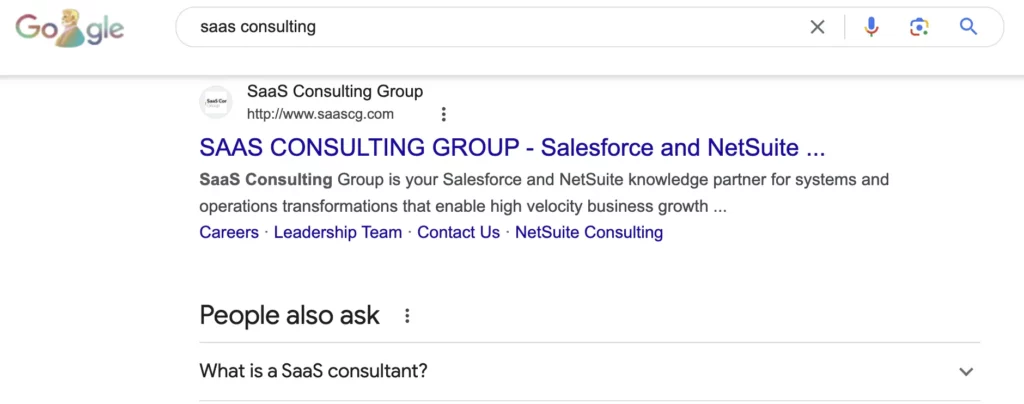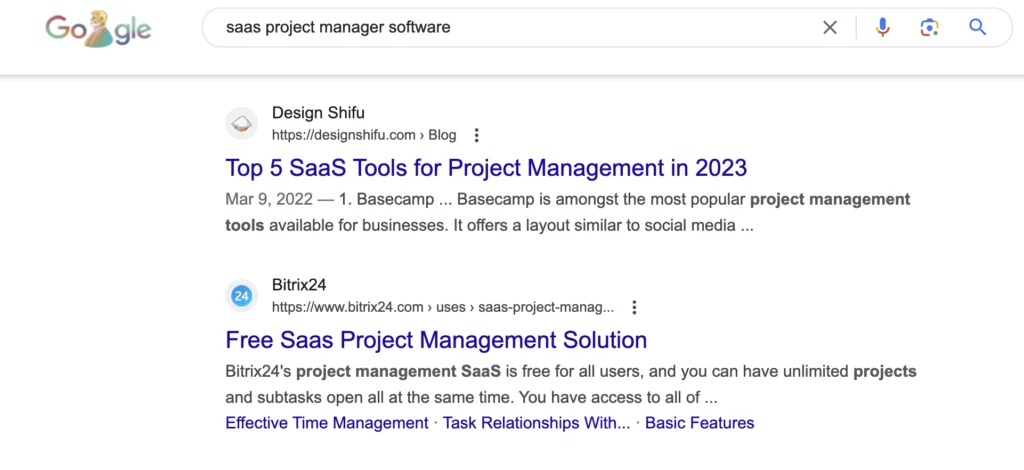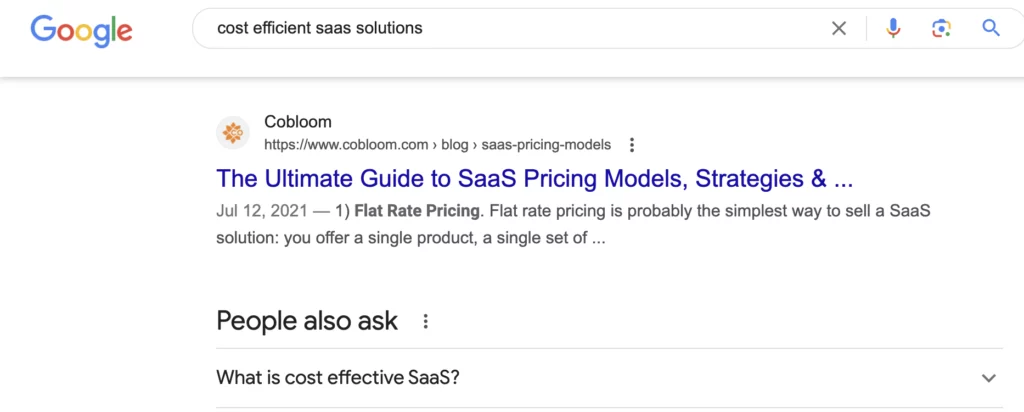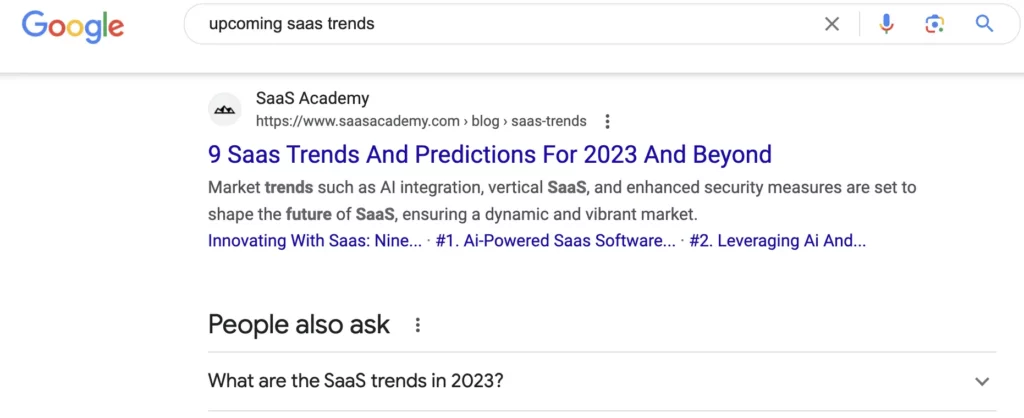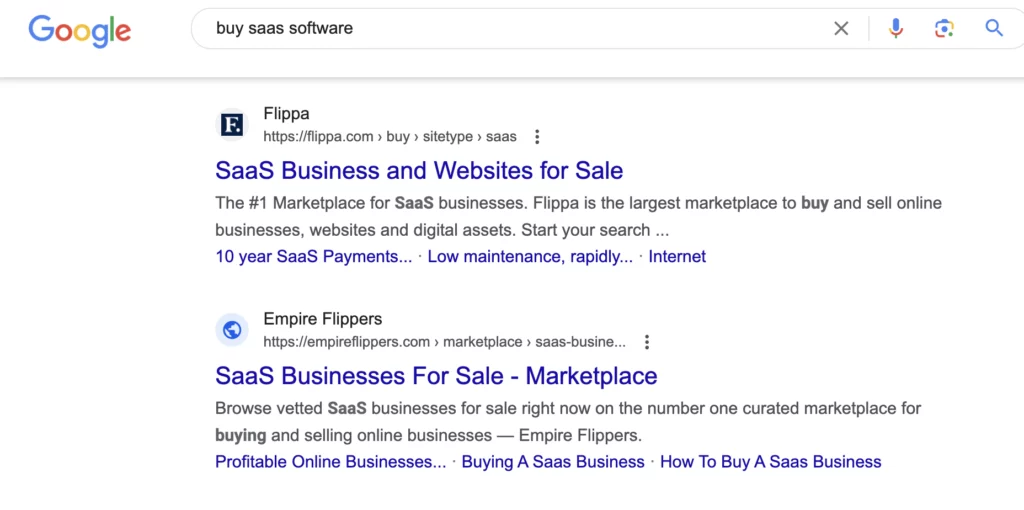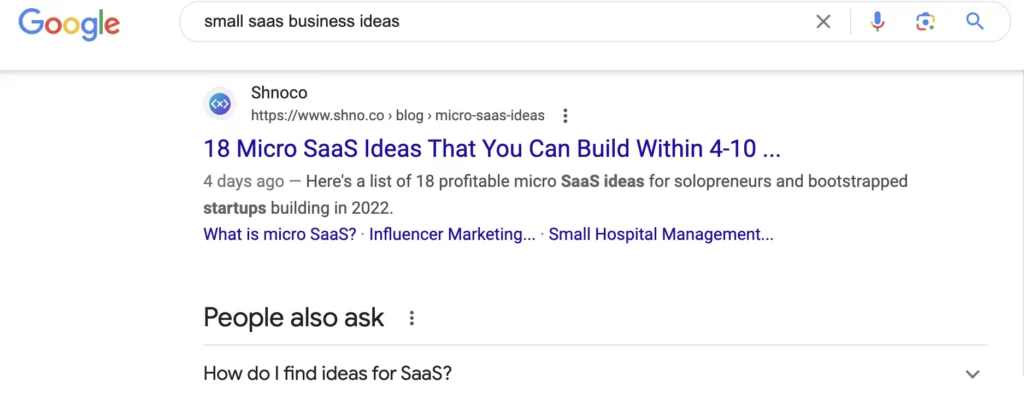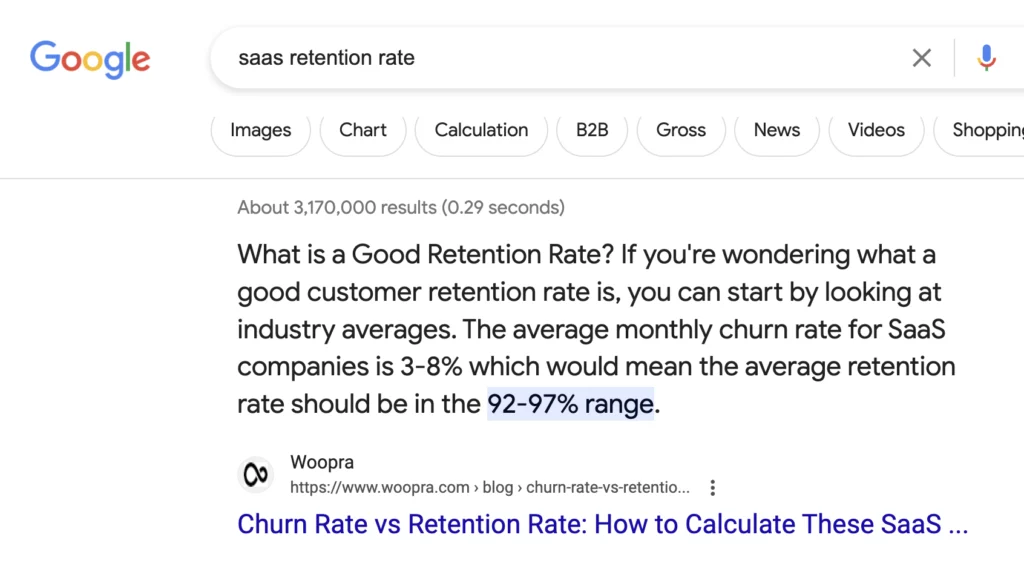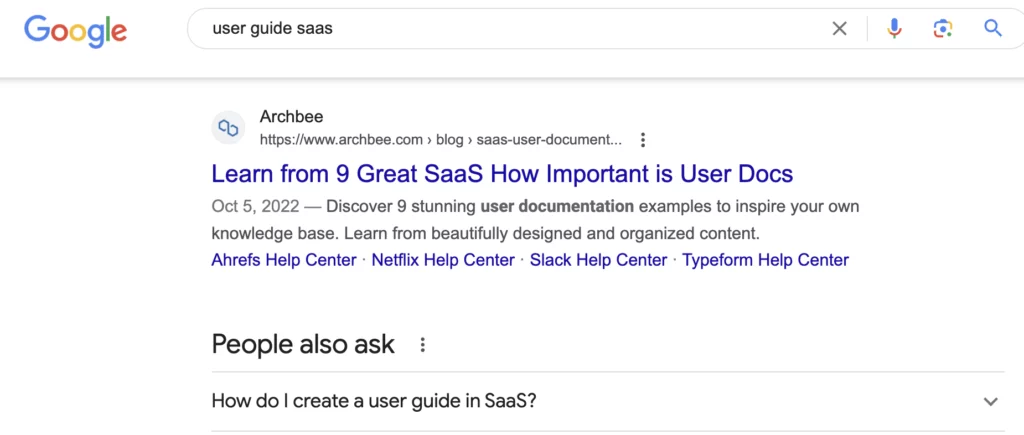B2B keyword research is the compass guiding businesses to their target audience, ensuring they’re discovered and chosen in the vast digital landscape. Still, it can be challenging due to ever-evolving search algorithms and competition. But hold on tight because we’re about to unveil the secrets of B2B keyword research and show you how to dominate it like a true champion.
This comprehensive guide will provide practical insights, answer your most burning SEO questions and guide you toward keyword research mastery.
What is B2B keyword research?
B2B keyword research is the process of identifying the most important keywords or phrases for the primary target audience of your business. These carefully chosen search terms form the foundation of your online presence. They serve as the connective link between your business and potential clients or partners actively seeking your solutions.
B2B keyword research involves selecting the most relevant and high-impact words and phrases for your online content. Other businesses searching for your products or services can find you through these keywords.
The importance of keyword research for B2B marketing
B2B keyword research entails mapping out the language your potential clients or partners use when looking for what you offer. Understanding and using these keywords effectively ensures that your website content ranks well on the search engine result page (SERP). This is important because, as Gartner highlights, the B2B buyers’ journey is evolving, and buyers spend only a limited portion of their time interacting with potential suppliers.
How is B2B keyword research different from standard keyword research?
B2B keyword research stands apart from typical keyword research (B2C) due to its specific business audience, often involving keywords with low search volume that cater to specialized and technical industries. These keywords address complex products or services and consider various stages of the B2B sales funnel. In contrast, standard keywords target consumer needs and typically have a high search volume, leading to broader competition.
Key metrics such as “search volume” help assess keyword popularity, with low search volume indicating niche appeal, while “keyword difficulty” estimates the competition level. Cost per click (CPC) measures the cost per click in online advertising, reflecting bid competition, which can be high for high search volume keywords in the B2C space.
These metrics guide SEO and advertising strategies for optimizing keyword performance in B2B and B2C contexts.
Who are we targeting in B2B SEO keyword research?
B2B keyword research primarily serves a professional audience — not only SEO specialists but also business owners, executives, product managers, marketing professionals and sales teams. These individuals seek to understand the search intent and behavior of B2B customers to use specific keywords to improve their online visibility and target potential clients.
How to conduct keyword research
Now that you understand your audience, it’s time to embark on the keyword research journey. Here are ten essential steps on how to do B2B keyword research:
1. Identify seed keywords
Begin by brainstorming core industry terms and analyzing your website content. Gather insights from your sales team and customers, study competitor strategies and engage in industry forums.
Use keyword research tools like Semrush and explore Google Autocomplete and Related Searches. Additionally, consider synonyms and variations of core terms. This will help you establish a strong foundation of seed keywords, a critical component for a successful B2B strategy.
You can also use keyword modifiers to find variations of your seed keyword. A keyword modifier is a term or phrase added to a primary keyword in SEO to refine and specify search intent, helping to target a more specific audience. For instance, if you offer hotel management software for the hospitality sector, key phrases like “hotel management software” and “hospitality industry” are essential.
Here are top 10 keyword modifier types:
1. Industry-specific modifiers
These keywords tailor your content to a specific industry or niche, making it more relevant to your target audience. For example, the keyword “saas technology” indicates a specific interest in the software industry.
2. Location-based modifiers
They enhance local SEO by adding geographic information to your keywords, helping businesses reach nearby customers effectively. An example is a search for “local saas companies.”
3. Product or service-related modifiers
These keywords specify the type of offerings you provide, improving search results accuracy. Here is an example of a product-related modifier on SERP.
4. Buyer persona or job title modifiers
Keywords that align your content with the roles or job titles of potential customers, ensuring it resonates with your audience. This SERP image shows us an example of a job title modifier.
5. Solution-based modifiers
These keywords emphasize how your products or services address specific problems, attracting problem-solving searchers. For example, the keyword below indicates the search for a specific solution that addresses cost-efficiency concerns.
6. Time-related modifiers
Keywords linked to timeframes or trends to keep your content current and engaging for readers. For example, “upcoming saas trends” indicates a timeframe.
7. Action-based modifiers
Keywords that prompt users to take specific actions, such as clicking, buying or subscribing. For example, the keyword “buy saas software” indicates an action.
8. Size or scale modifiers
Keywords that relate to the size or scale of products or businesses, catering to diverse customer needs. For example, the keyword “small saas business ideas” indicates the size of the business the user is looking for.
9. Problem-specific modifiers
Keywords targeting particular pain points or challenges your audience faces, showcasing your solutions. Here is an example of a problem-specific modifier keyword “saas retention rate” on SERP.
10. Modifier for content types
Keywords that specify the format or type of content, helping users find the content they prefer. Here is an example of a search looking for a specific type of content: a user guide.
Keyword modifier examples for B2B keyword research
| Keyword modifiers | Example 1 | Example 2 | Example 3 | Example 4 | Example 5 |
|---|---|---|---|---|---|
| Industry-specific modifiers | Manufacturing | Technology | Finance | Retail | Energy |
| Location-based modifiers | USA | International | Global | Local | Asia-Pacific |
| Product or service-related modifiers | Software | Consulting | Solutions | Providers | Suppliers |
| Buyer persona or job title modifiers | IT manager | Marketing director | Procurement officer | HR executive | Enterprise |
| Solution-based modifiers | Cost-effective | Efficient | High-quality | Innovative | ROI |
| Time-related modifiers | 2023 | Upcoming | Trends | Latest | Current |
| Action-based modifiers | Buy | Find | Compare | Implement | Evaluate |
| Size or scale modifiers | Small business | Medium-sized | Large enterprise | SMEs | Fortune 500 |
| Problem-specific modifiers | Security | Compliance | Efficiency | Cost reduction | Customer retention |
| Modifier for content types | Guide | Case study | Blog | Infographic | Video |
With the help of keyword modifiers, we can understand at what stage the customers are in their buying journey. When we think about B2B purchases, they usually take longer and involve different stages:
- Awareness stage. This is when people are just looking for information. Using keywords like “latest trends in hotel technology” can help you catch their interest.
- Consideration stage. Buyers are comparing options. Keywords like “comparing hotel booking engines” can give them the details they need to make smart choices.
- Decision stage. This is when people are ready to make a choice and buy something. Keywords like “pricing of hotel channel management systems” can help them decide.
In a B2B context, searchers tend to use longer and more specific search phrases when they’re trying to find solutions to tricky problems. So, it’s important to focus on those keywords that match what people are looking for. We’re talking about something called long tail keywords.
What are long tail keywords?
Long tail keywords are detailed, specific search phrases containing three or more words to attract a more focused and niche audience in SEO efforts. They are less competitive and better suited for targeting particular user intents.
Even though long tail keywords have lower search volumes, they’re important because they are what users want. And that often leads to more sales or conversions.
2. Analyze your competitive landscape
Understand the competitive landscape and keywords and identify missing keywords within your B2B niche. Competitors may be targeting specific keywords or industries.
Don’t forget to spy on your competitors (in a perfectly ethical way, of course!). It’s like peeking at what your competitors are up to with their keywords. Identify which keywords are driving traffic to their websites.
Competitive analysis can be a source of inspiration for effectively shaping your B2B SEO keyword strategy within your niche.
Here’s how you can do it, and I’ll throw in some handy tools for the job.
Identify your competitors
You need to figure out who your competitors are. You probably have a good idea, but if not, you can use tools like Semrush or Ahrefs to see who’s ranking for keywords related to your business.
Analyze your competition’s websites
Go to your competitor’s website and look for the keywords they’re using. Pay attention to their content, meta tags and even their blog posts. Tools like SpyFu can help you spy on their keywords.
Check competitors’ backlinks
Backlinks (links from other websites to theirs) can give you valuable insights. Tools like Semrush can help you see which websites link to your competitors. Sometimes, these websites can be good targets for your link-building efforts.
Look at your competitors’ paid ads
If your competitors are running pay-per-click (PPC) ads, tools like iSpionage or Semrush can help you see which keywords they’re bidding on. Advertising research can give you ideas for keywords to target in your own campaigns.
Compare rankings
Use tools like Moz or Ahrefs to compare your website’s rankings with those of your competitors. Are there keywords where you’re outperforming them? Are there areas where they’re ahead? This information can help you fine-tune your SEO strategy.
Monitor ranking changes
Competitor analysis isn’t a one-time thing. Keep an eye on your competitor’s keywords regularly. Tools like Google Alerts or Mention can help you track online mentions and uncover new keywords they might be targeting.
Remember, the goal here is not to copy your competitors but to get insights that can help you refine your B2B keyword strategy.
3. Take into account your ideal customer profile (ICP)
Ideal customer profiles (ICPs) help businesses target the most promising customer segments, making enterprise keyword research more precise and cost-effective. Businesses can maximize ROI and ensure their messaging resonates effectively by honing in on the right audience.
ICPs foster data-driven decision-making, giving a competitive edge in keyword selection. Understanding personas, a key component of ICPs, is essential as they provide a detailed picture of your ideal customers. They help tailor keywords and content, resulting in more impactful marketing campaigns, higher conversion rates and, ultimately, business growth.
Free download: ICP template for B2B teams
4. Use partnership and collaboration keywords
In B2B keyword research, harnessing the potential of partnership and collaborative keywords involves a strategic approach. Start by identifying relevant business partners or collaborators in your industry and understanding the context of these alliances, whether they entail joint ventures, co-marketing initiatives or shared resources.
Once you have a clear grasp of your partnerships, embark on keyword research to pinpoint associated terms and phrases. This might encompass industry-specific terminology, the names of partner organizations or keywords reflecting the collaborative nature of your projects.
Post that, integrate these partnership and collaborative keywords into your website content, ensuring they align with the specific objectives of your partnerships. This optimizes your content for search engines and signals your commitment to collaborative efforts. Consider link-building strategies to enhance the visibility of your partnership-related content, ultimately strengthening your B2B relationships and online presence.
For instance, if you’re a hotel business collaborating with a software company that provides hospitality solutions, include phrases like “saas solutions for hotel management” within your content to boost your online visibility for such partnerships. This tactic makes your content more relevant to search engines and potential clients seeking partnership-specific services.
5. Leverage personalized keywords
In the B2B world, personalization is a bit like tailoring a suit — it’s all about fitting your solutions perfectly to your client’s needs. If your B2B offerings involve customization or tailored services, use keywords that suggest this. For example, “customized financial advisory services” tells potential clients you’re all about customizing your services to meet their unique needs.
These keyword categories make it easier for businesses looking for partnership opportunities, data-driven solutions or personalized services to find you online.
Now that we have completed our research phase, we transition into the next step of keyword research — shortlisting essential keywords. Once you’ve gathered a substantial list of potential target keywords depending on your brand, it’s time to add specific data to make informed final decisions.
6. Use tools to find more keywords
Once you have keyword ideas to run with, the next step is to put them in a keyword research tool such as Semrush, Ahrefs, Moz or Google AdWords.
These tools offer a treasure trove of keyword suggestions, including related terms, synonyms and long tail variations, broadening your horizons beyond your initial ideas. They provide essential data, such as search volume and keyword difficulty, helping you prioritize search terms that align with your goals and are feasible to rank for.
By peeking into the keyword strategies of your competitors, you can uncover untapped opportunities, while tools’ insights into question-based, local, seasonal and trending keywords empower you to craft timely and engaging content. Overall, these tools save time and unlock the potential for higher organic traffic and improved content relevance.
Let’s look at the pros and cons of these tools:
Google Keyword Planner
This free tool offers keyword suggestions based on your input, historical search volume data and competition levels. It’s particularly useful for businesses starting with keyword research.
- Pros: Integration with Google Ads, precise search volume data and free to use with a Google account.
- Cons: Limited in-depth competitive analysis and may not provide data on long tail keywords.
Semrush
Semrush is a comprehensive SEO tool that provides keyword research and competitor analysis tracking. It offers keyword difficulty scores, search volume and trend data.
- Pros: Extensive database, excellent competitor analysis and helpful for tracking keyword performance over time.
- Cons: It can be cost-intensive for small businesses, and the interface may seem overwhelming for beginners.
Ahrefs
Ahrefs is renowned for its backlink analysis but also excels in keyword research. It offers detailed keyword metrics, including keyword difficulty, search volume and click-through rate (CTR) estimates.
- Pros: Accurate keyword data, robust competitor analysis and comprehensive SEO tools.
- Cons: Higher cost compared to other tools, which may not be suitable for smaller businesses.
Moz Keyword Explorer
Moz’s Keyword Explorer provides keyword suggestions, search volume data and keyword difficulty scores. It also offers SERP analysis to help you understand the competition.
- Pros: User-friendly interface, reliable keyword difficulty scores and integration with other Moz tools.
- Cons: Limited free features and some users may find its keyword database smaller than competitors like Semrush and Ahrefs.
7. Use non-SEO tool-based keyword research methods
By exploring other innovative and non-conventional approaches for keyword research, you can unlock new opportunities for optimizing content and enhancing online visibility. Let me show you the tools you can use:
G2 reviews
G2 is my go-to for candid user insights on software and tech products. This user-generated content (that is vetted) is pivotal in SEO to boost search rankings and organic traffic. Leveraging G2’s user reviews can be a strategic SEO move to research more personalized B2B tech keywords.
Here is how you can use G2 reviews for keyword research:
- Choose your focus: Determine the specific product or industry you want to target for keyword research, ensuring a clear direction for your investigation.
- Explore reviews: Visit G2 reviews and delve into user-generated feedback, noting the common keywords and phrases users use to describe their experiences, issues and advantages.
- Analyze ratings and tags: Consider the overall ratings of products and examine any descriptive tags or labels users have applied to gain insights into product features and qualities that resonate with users.
- Leverage user questions: Pay attention to questions and concerns raised by users in reviews, as these can offer valuable long tail keyword opportunities for addressing specific user needs and issues.
- Create content: Use the collected keywords to craft content such as blog posts, product descriptions, FAQs and marketing materials while keeping an eye on G2 reviews for ongoing trends and updates in user sentiment.
Forrester Wave reports
The Forrester Wave report serves as a reference tool to aid buyers in their decision-making process within a technology marketplace, relying on our in-depth analysis.
Here is how you can use Forrester Wave reports for keyword research:
- Identify industry-specific keywords: Analyze Forrester reports to identify keywords and terminology commonly used in your industry or technology niche.
- Competitor insights: Examine how the reports describe and position vendors and competitors to understand effective keywords and descriptors
- User language: Pay attention to how the reports discuss user needs and benefits to align your content with the language your target audience uses.
- Long tail keywords: Extract potential long tail keywords from detailed product descriptions and use cases in the reports for niche targeting.
- Content and ad campaign optimization: Use the identified keywords for content creation and online advertising campaigns to ensure relevance and resonance with industry trends and customer language.
Product demos
Watching product demos also helps to identify keywords and phrases that potential customers are using when researching and evaluating products. Here is how you can use product demos for keyword research:
- Identify User Queries: Listen to questions and concerns raised during demos to discover keywords reflecting customer challenges.
- Gather Feedback: Note terminology used for feature requests to find relevant keywords.
- Analyze Competitor Comparisons: Identify keywords when prospects compare your product with competitors.
- Understand Use Cases: Learn industry-specific terms and phrases during discussions about product use cases.
- Gauge User Reactions: Identify positive keywords customers use when expressing enthusiasm about your product’s strengths.
Press releases and news wires
Although press releases and news wires are not typically primary tools for keyword research, they can indirectly contribute to your keyword strategy and SEO efforts. Here is how you can use press releases and news wires for keyword research:
- Identify competitors: Determine your main competitors in your industry or niche.
- Gather competitor press releases: Visit competitors’ websites and access their press release sections or archives.
- Analyze keywords: Examine the keywords and phrases used in your competitors’ press releases.
- Identify trends and common keywords: Look for recurring themes and common keywords across multiple press releases.
- Expand and implement: Add competitor-derived keywords to your research, check search volume and competition and use these keywords strategically in your content and SEO efforts.
Industry-specific publications/news sources
Industry-specific publications and news sources provide real-world insights into the language your target audience uses.
Here is how you can use industry-specific publications/news sources for keyword research:
- Identify relevant publications: Find reputable industry-specific publications and news sources that cover topics related to your business or niche.
- Monitor content regularly: Subscribe to or regularly visit these sources to stay updated on the latest industry news, trends and terminology.
- Analyze content keywords: Pay attention to the keywords, phrases and terminology used in articles, headlines and editorials. Take note of terms that appear frequently.
- Create a keyword list: Compile a list of the keywords and phrases you’ve identified. Include both broad and specific terms that are relevant to your industry.
- Incorporate keywords strategically: Use the keywords you’ve gathered in your website content, blog posts and SEO optimization. Ensure that the language aligns with the terminology commonly used by your target audience in the industry.
Generative AI tools
Generative AI tools like ChatGPT are invaluable for generating ideas in diverse areas. To make the most of it, provide context, whether it’s for content, marketing or research. Ask open-ended questions, seek suggestions and remember that the model’s responses are pattern-based. Your expertise is crucial in evaluating ideas. Keep the conversation dynamic by refining questions and seeking more details.
My favorite AI prompts to help with keyword research:
- Perform keyword research to identify the most relevant and high-volume keywords related to [your topic], and create an introductory piece incorporating these keywords. Include historical context and discuss the topic’s contemporary relevance.
- Identify long tail keywords and search queries related to [your topic], and use them to craft a detailed article that explains key concepts and provides real-world examples.
- Conduct keyword research to discover high-ranking keywords associated with the benefits and advantages of [your topic]. Craft an in-depth article or landing page around these keywords.
Learn how to scale your SEO content efforts with AI writing
8. Select the right target keywords
Once we have compiled a list of keywords, the next step is to narrow it down to the most pertinent ones that align with your brand. Base this selection on the following criteria:
Search volume per month
Assess the monthly search volume of keywords within your B2B niche. This metric helps gauge the potential traffic you can attract from professionals and businesses seeking your offerings.
Keyword difficulty
Evaluate the keyword difficulty within your B2B sector to understand the competitiveness of specific terms. Aim for a mix of high and low-difficulty keywords that align with your industry’s competitive landscape.
Relevancy to B2B solutions
Ensure the keywords you select are highly relevant to the B2B solutions or services you provide. Irrelevant keywords can lead to wasted efforts and ineffective marketing within the B2B space.
Keyword intent analysis
Dive deep into analysis and explore the different types of keyword intent:
| Keyword intent | Definition | Example keywords |
|---|---|---|
| Informational intent | B2B buyers often seek educational content. They're looking for facts, explanations, guides or how-to content. | Hospitality industry trends How to improve guest satisfaction |
| Navigational intent | Users want to reach a specific website or web page. They might enter a brand name or specific URL in the search bar to access that site directly. | Marriott hotel website Hilton reservations login |
| Transactional intent | Users want to reach a specific website or web page. They might enter a brand name or specific URL in the search bar, aiming to access that site directly | Book a room at Holiday Inn Reserve a table at a seafood restaurant |
| Commercial intent | Users are in the consideration phase and are comparing products, services or options before making a purchase decision. They may search for product reviews, comparisons or pricing information. | Best hotel loyalty programs Hotel vs. AirBnb: Pros and consv |
| Local intent | Users are looking for information about nearby businesses or locations. Local intent is essential for brick-and-mortar businesses and involves keywords like "near me," "in [city]" or "near [landmark]." | Hotels near Disney World Orlando Seafood restaurants in San Francisco |
Current ranking position and URL
Monitor your current ranking positions for B2B keywords with position tracking on various SEO tools and the associated URLs. Identify which keywords drive B2B traffic to your site and optimize existing pages or create new ones tailored to the B2B audience.
Business impact
Evaluate the potential impact of keywords on your B2B company using a scale of 1 to 5, with 5 representing the highest potential for generating revenue and leads in the B2B sector. Prioritize high-impact keywords while recognizing the supportive role of low-impact ones in your B2B SEO strategy.
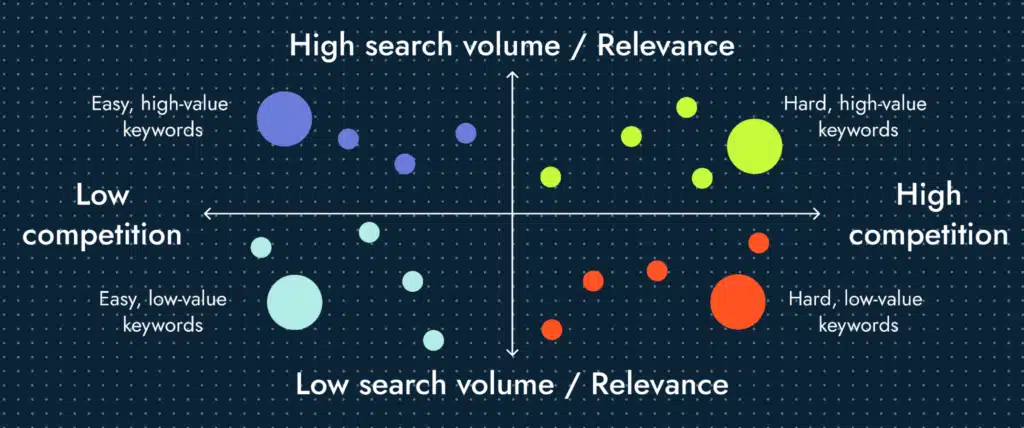
9. Cluster your keywords
Keyword clustering is the practice of grouping related keywords together based on their semantic similarity and relevance. By organizing keywords into clusters, businesses can create content strategies to improve their website’s structure and enhance their online visibility.
This approach enables a more strategic and coherent approach to targeting specific topics and audience interests, leading to higher search engine rankings, increased website traffic and better user experience. With your target keywords in hand, the next step is strategically aligning them with your website’s landing pages and articles. The rule of thumb is to ensure we target one page for one keyword cluster and vice versa.
10. Map your keywords
Now that we have our keyword groups ready, we need to map one page per cluster/group.
B2B keyword mapping, also called keyword harvesting, helps create a clear roadmap for your SEO efforts and content creation. By linking specific keywords to particular pages or content pieces on your website, you ensure your site is well-optimized for relevant search queries.
Keyword mapping helps prevent keyword cannibalization by assigning specific keywords to individual pages, ensuring content alignment and optimizing user intent, ultimately improving search rankings and user experience. It also helps you keep tabs on how well individual keywords perform, allowing you to fine-tune your strategies as needed. It’s critical to achieving SEO success and driving organic traffic to your website.
Move forward with keyword research for B2B SEO
So, you’ve finished reading this guide 👏 and by now, you’ve completed your keyword research, organized your keywords into clusters and skillfully associated them with the relevant pages on your website. But the journey to effective B2B SEO keyword research doesn’t end here. It’s an ongoing process that continually evolves with changes in your industry and the ever-shifting preferences of your target audience.
This is where we come into play. Our suite of digital solutions is tailored to empower B2B SaaS businesses in their enterprise keyword research endeavors — so you can stay agile and responsive to the dynamic nature of online searches.
Partner with us, and you’ll find that B2B keyword research becomes a seamless, productive process, positioning your business for success. Let’s discuss your growth goals.



